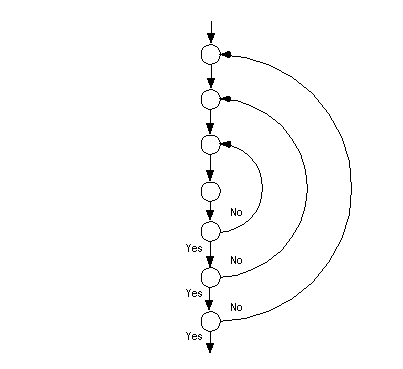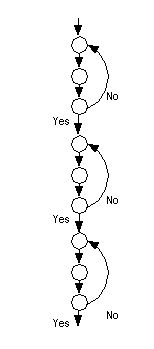Location:
[CPSC 333]
[Listing by Topic]
[Listing by Date]
[Previous Topic]
[Next Topic]
Loop Testing
This material was covered during lectures on March 31, 1997.
The goal of loop testing is to test while-do,
repeat-until, (or do-while) and any other loops in a
program thoroughly - by trying to ensure that each is executed at
minimal, typical, and (if this is defined) maximal values - and to try to
``break'' the program, by trying to have a loop executed with a fewer than
minimum, as well as a larger than maximal, number of iterations.
Loop testing is discussed, briefly, in recent editions of
Pressman's Software Engineering:
A Practitioner's Approach.
Three types of loops (or, more accurately, combinations of loops) will
be tested.
-
Simple Loops are loops whose
loop bodies contain no other loops (so, these
are the ``innermost'' loops if any loops are nested).
-
Nested Loops are combinations
of loops such that each is contained inside the loop body of the next.
Here is a sketch of three nested repeat-until loops:

Concatenated Loops
are loops such that each follows the next in the code - that is, the
execution of the next loop begins after the previous terminates.
Here is a sketch of three concatenated repeat-until loops:

The ``guidelines'' for loop testing consist of lists of test cases
that should be included for each type of loop.
- Try to design a test in which the loop body isn't executed at all.
- Try to design a test in which the loop body is executed exactly
once.
- Try to design a test in which the loop body is executed exactly
twice.
- Design a test in which a loop body is executed some ``typical''
number of times.
If there is an upper bound, n, on the number of times the loop body
can be executed, then the following cases should also be applied.
- Design a test in which the loop body is executed exactly n-1 times.
- Design a test in which the loop body is executed exactly n times.
- Try to design a test causing the loop body to be executed exactly
n+1 times.
Apply the following guidelines to ensure that each loop is tested at
its boundaries (that is, with both minimal and maximal numbers of
iterations of the loop body) while using a number of tests that is
only linear in the number of loops:
- Conduct the ``simple loop tests'' for the innermost loop (which
is a simple loop), while keeping the number of iterations of the
outer loops at their minimal nonzero values.
- Work outward, conducting tests (as described above) for each loop,
while holding the number of iterations of outer loops at the
minimal nonzero values possible (that is, the minimal values that can
be used when
the inner loop body is to be executed the desired number of times),
and holding the number of iterations of
inner loops at ``typical'' values.
If the loops are ``independent,'' so that the number of iterations used
for one loop doesn't depend on the number of iterations used for any
other(s), then it is sufficient to apply the guidelines for simple loops
to each of the loops in the sequence.
On the other hand, if the number of iterations used for one loop
does depend on the number of iterations used for another, then
the following guidelines should be used instead.
- Conduct ``simple loop tests'' for the bottom (or ``last'')
loop in the sequence, holding the number of iterations of the
higher (or ``previous'') loops at minimal values.
- Work up toward the top loop, considering each loop in turn, and
applying ``simple loop tests'' for each loop in turn, keeping the
number of iterations of upper loops at minimal values and keeping
the number of iterations of lower loops at typical values.
Consider, again, the sorting
program that is being used as an example for unit testing.
This program contains two nested while-do loops.
In this example,
the maximum possible number of iterations of the inner loop (on any
execution of that loop) is one less than the value of the variable
i, since the integer variable j is initialized to have
value i-1 before the inner loop begins, the variable j
is decremented in the inner loop's loop body, and the loop test fails
as soon as the value of j becomes less than or equal to zero.
The minimal possible number of iterations of the inner loop
body is zero, since the loop test can fail immediately (and, it
does so if A[i-1] is less than or equal to A[i]
when this test is performed).
Finally, it should be noted that when the execution of the inner loop
body begins, for a given value of i, the element in position
A[i] of the array is the element that was in position when
the program began execution, while the elements in positions A[1],
A[2], ..., A[i-1] have been arranged (amongst
themselves), so that they appear in the array in increasing order
at this time.
If k is between 0 and ishould be) executed exactly ktimes at this point,
if and only if A[i] is smaller than exactly k of the elements
that appeared in the first i-1 positions of the input
array: For, when the inner loop is executed for the given value of
``i'', the entries in the first i-1 positions will have
been sorted. Therefore, the distance that the element (originally)
in position i will need to be moved forward, in order to sort
the first i entries of the array, is the same as the number of
entries in the first i-1 positions than are smaller than this
element - and this is the same as the number of iterations of the inner
loop body used at this point.
Figuring out the number of executions of the outer loop body
is much easier: This loop will always be executed exactly
n-1 times, if n is the size of the input array.
Let's assume that this program is supposed to be able to sort arrays
of length at least 100. Then both the inner and outer loop
should be tested on inputs of ``moderate'' sizes (say, some size between
40 and 60), as well as on sizes 1, 2, 99, and 100. In order to keep
the number of iterations of the inner loop at ``typical'' values while
trying to control the number of iterations of the outer loop, it will
probably be sufficient to start with an array with distinct elements
whose entries are ordered in a random way. In order to keep the
number of iterations of the inner loop at a ``minimal'' value, use
an input array that is already sorted in increasing order. In order
to keep the number of iterations of the inner loop at a maximal
value, you should use an input array with distinct entries, that are
initially sorted in decreasing order instead of increasing order.
If you examine the tests that were obtained for this program using
path testing and condition testing, then you will
find that none of the use input arrays whose length is more than 4,
so none of them require execution of either the inner or outer loop
body more than three times (at any time when the loop is executed). Worse
yet, none of them require the inner loop body to be executed more
than once, at any time when it is called. Thus, we'll add one more test
(with the inner loop body executed twice when the inner loop is
executed) in order to complete the testing of the loops at the minimal
values, and we'll add tests to ensure that the loops are tested at
both ``typical'' and ``maximal'' values, as well.
The test that will be added to ensure that the inner loop body is
executed twice is as follows.
Test #8
Inputs: n = 3; A[1] = 3, A[2] = 2, A[1] = 1
Expected Outputs: A[1] = 1, A[2] = 2, A[3] = 3
Now, to complete ``simple loop testing'' for the inner loop, we'll
try to develop tests causing the loop to executed 50 times, 98 times
99 times, and 100 times. In order do this while ``keeping the number
of executions of the outer loop as small as possible,'' we'll use
tests with arrays of length 51, 99, 100, and 101 respectively, such that
the smallest element is at the end of the input array in each case.
For the sake of a little more variety in the tests, different relative
orderings
will be chosen for the rest of the elements, in the four tests
that are given.
Test #9
Inputs: n=51, A[i] = i for i between
1 and 50, and A[51] = 0
Expected Outputs: A[i] = [i-1] for i
between 1 and 51
Test #10
Inputs: n=99,
- A[i] = 1 if i is between 1 and 98 and is even,
- A[i] = 2 if i is between 1 and 98 and is odd,
- A[99] = 0
Expected Output:
- A[1] = 0,
- A[i] = 1 if i is between 2 and 50,
- A[i] = 2 if i is between 51 and 99
Test #11
Inputs: n = 100, A[i] = 101 - i for i
between 1 and 100
Expected Outputs: A[i] = i for i
between 1 and 100
Test #12
Inputs: n = 101,
- A[i] = 2 if i is between 1 and 50,
- A[i] = 1 if i is between 51 and 100,
- A[101] = 0
Expected Outputs:
- A[1] = 0,
- A[i] = 1 if i is between 2 and 51,
- A[i] = 2 if i is between 52 and 101
Finally, in order to complete testing of the outer loop, tests
should be designed in which the outer loop is executed (approximately)
50 times, 98 times, 99 times, and 100 times, while keeping the number
of executions of the inner loop at ``typical'' values.
In order to keep behaviour of the inner loop ``typical,'' we'll simply
choose ``random'' inputs. One way to do this, if the array is to have
length n, would be choose the inputs A[i] uniformly
and independently from the set of integers between 1 and
n - assuming that the program really will be
applied to ``randomly arranged'' arrays. These details should probably
be the changed (so that they reflect the way the program will actually
be used) if this in't the case.
You could do this to develop Tests #13, #14, #15, and #16, using
the values 51, 99, 100, and 101 for n, respectively. After
doing this, the ``inputs'' would have been determined; the ``expected''
outputs would be the same values, rearranged in increasing order.
The tests could then be written down, using (essentially) the same
format as has been used for the first twelve tests that have been
developed for this program.
Lab Exercise
A lab exercise
based on this material is also available.
Location:
[CPSC 333]
[Listing by Topic]
[Listing by Date]
[Previous Topic]
[Next Topic]
Loop Testing
Department of Computer Science
University of Calgary
Office: (403) 220-5073
Fax: (403) 284-4707
eberly@cpsc.ucalgary.ca

